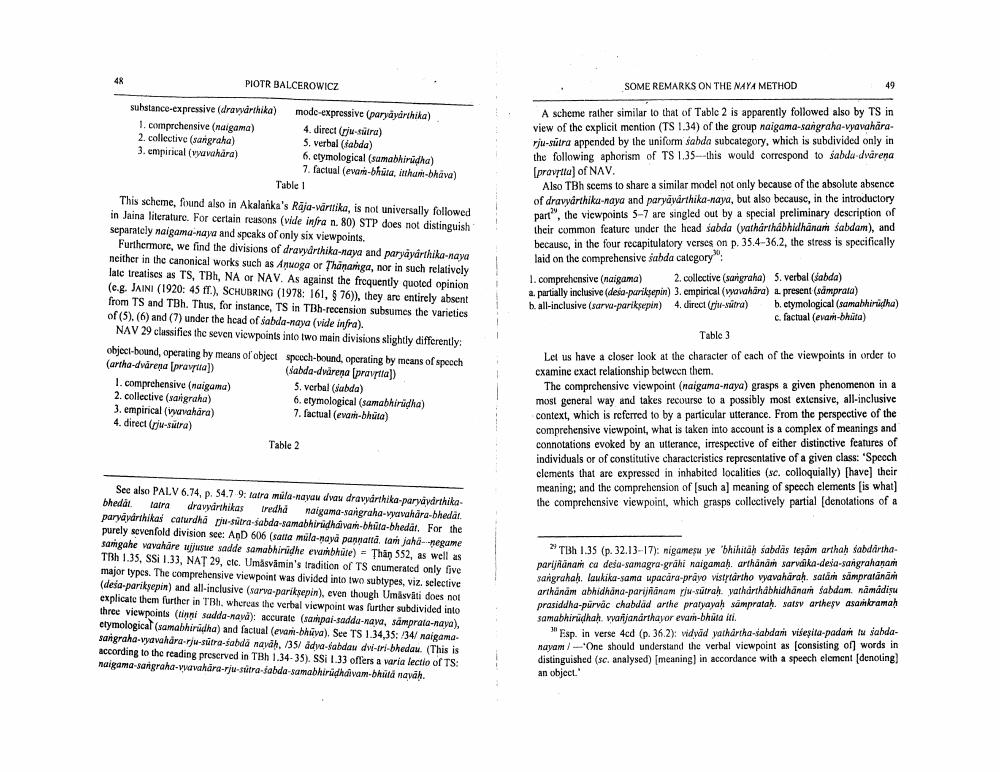________________
SOME REMARKS ON THE NAYA METHOD
PIOTR BALCEROWICZ substance-expressive (dravarthika) mode-expressive (paryayarthika) 1. comprchensive (naigama)
4. direct (ju-sutra) 2. collective (sangraha)
5. verbal (sabda) 3. empirical (vyavahara)
6. ctymological (sumabhirudha)
7. factual (evan-bhuta, inthani-bhava)
Table 1 This scheme, found also in Akalanka's Raja-vārtika, is not universally followed in Jaina literature. For certain reasons (vide infra n. 80) STP does not distinguish separately nalgama-naya and speaks of only six viewpoints.
Furthermore, we find the divisions of dravydrthika-naya and paryayarthika naya neither in the canonical works such as Amuoga or Thananiga, nor in such relatively late treatises as TS, TBh, NA or NAV. As against the frequently quoted opinion (c.g. JAINI (1920: 45 ff.), SCHUBRING (1978: 161, $76)), they are entirely absent from TS and TBh. Thus, for instance, TS in Bh-recension subsumes the varieties of (5). (6) and (7) under the head of sabda-naya (vide infra).
NAV 29 classifies the seven viewpoints into two main divisions slightly differently: object-bound, operating by means of object speech-bound operating by means of speech (artha-dvdrena (prava])
(Sabda-dvarena (prava]) 1. comprehensive (naigua)
5. verbal (sabda) 2. collective (sangraha)
6. etymological (samabhirudha) 3. empirical (wvavahara)
7. factual (evant-bhuta) 4. direct (ru-sutra)
Table 2
A scheme rather similar to that of Tablc 2 is apparently followed also by TS in view of the explicit mention (TS 1.34) of the group naigama-sangraha-Vyavahararju-sūtra appended by the uniform sabda subcategory, which is subdivided only in the following aphorism of TS 1.35-this would correspond to sabda-dvarena (provrta of NAV.
Also TBh scems to share a similar model not only because of the absolute absence of dravyárthika naya and paryavarthika-naya, but also because, in the introductory part", the viewpoints 5-7 are singled out by a special preliminary description of their common feature under the head sabda (vatharthábhidhanuri sabdam), and because, in the four recapitulatory verses on p. 35.4-36.2, the stress is specifically laid on the comprehensive sabda category": 1. comprehensive (naigama) 2. collective (sangraha) 5. verbal (sabda) a partially inclusive (desa-puriksepin) 3. empirical (wawahara) a present (samprata) b all-inclusive (sarw.pariksepin) 4. clirect (phu-satra) b. etymological (samahiridha)
c. factual (evam-bhuta)
Tablc 3 Let us have a closer look at the character of cach of the viewpoints in order to examine exact relationship between them.
The comprehensive viewpoint (naiguma-naya) grasps a given phenomenon in a most general way and takes recourse to a possibly most extensive, all-inclusive context, which is referred to by a particular utterance. From the perspective of the comprehensive viewpoint, what is taken into account is a complex of meanings and connotations evoked by an utterance, irrespective of either distinctive features of individuals or of constitutive characteristics representative of a given class: 'Speech clements that are expressed in inhabited localities (sc. colloquially) (have) their meaning, and the comprehension of (such a) meaning of speech elements is what) the comprehensive viewpoint, which grasps collectively partial (denotations of a
See also PALV 6.74, p. 54.7 9: latra mila-nayuu dva dravydrthika paryayarthikabhedát. tatra dravydirthikas tredha nalgama-sangraha-vyavahara-bhedat. parvavarthikas caturdha pin-sutra-sabda-samahiridhivart-bhuta-bhedat. For the purely sevenfold division see: AnD 606 (satta mila-naya pannafta tam jahategume sanigahe vavahare mjjuste sadde samabhinidhe evanbhute) Than 552, as well as Trh 1.35, SSI 1.33, NAT 29, etc. Umasvamin's tradition of TS enumerated only five major types. The comprehensive viewpoint was divided into two subtypes, viz. selective (desa-pariksepin) and all-inclusive (sarva-pariksepin), even though Umásviti does not explicate them further in Toh, whereas the verbal viewpoint was further subdivided into three viewpoints (tinni sudda-nava): accurate (sampai-sadda-naya, samprata-nya), etymological (samabhirudha) and factual (evan-bhuva). See TS 1.34,35:34/ naigamasangraha-Vyavahara-rj-sutra-sabda navah./35/ adva-sabdau dvi-tri-bhedan. (This is according to the reading preserved in TBh 1.34-35). SSI 1.33 offers a varia lectio of TS: naigama-sangraha-wavahdra-rj-sutra-sabda-samabhirudhaivam-bhutd navah.
2TBh 1.35 (p.32.13-17): nigamesu ve 'bhihitah sabdas tesam arthah sabdarthaparijanam ca desa-samagra-grāhi naigamah. arthánām sarvaika-desa-sangrahanam sangrahah, laukika-sama upacara pravo vistytártho vyavaharah, salah sampratanam arthanam abhidhana-parijanam yw sūtrahyarharthabhidhanan sabdam, namadisu prasiddha-pürvic chabdad arthe pranyayah sampratah satsy arthes asankramah samabhirudhah warjanarthajor evum-bhūta iti.
"Esp. in verse 4cd (p. 36.2); widvād pathartha-sabdan višeşita-padanh tu sadanayam / One should understand the verbal viewpoint as (consisting of words in distinguished (sc, analysed) (meaning) in accordance with a speech element (denoting) an object




